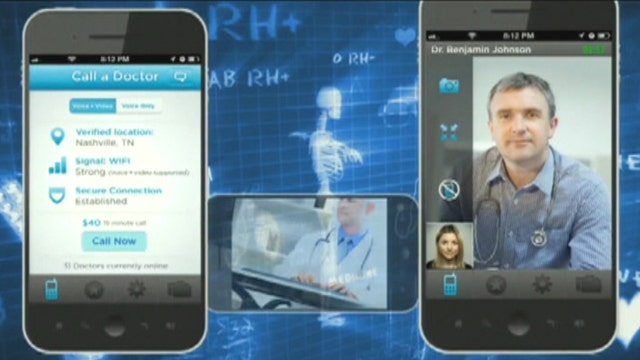New App Lets You Get Instant Healthcare Through Your Smartphone
A new app is giving American consumers a new way to get healthcare -- via their smartphones.
The "Doctor on Demand" app, which launched in 15 states this week, allows patients to skip the traditional visit to the doctor's office for a video chat instead.
Forty dollars buys you 15 minutes with one of Doctor on Demand's "on shift" doctors, with $30 going to the doctor and the remaining $10 to the company, which recommends using the service for run-of-the-mill issues like cold and flu symptoms, rashes, prescription refills or even sports injuries.
The app also allows you to send the doctor hi-res photos of the symptoms you’re describing. The physicians can then offer a diagnosis, prescribe you any non-controlled substance, or recommend that you see a doctor in person.
The launch makes Doctor on Demand the latest in a growing list of companies exploring telemedicine, joining the likes of Interactive MD, American Well, Healthcare Magic and TelaDoc.
The company already has secured $3 million in funding from big-name investors like Google Venture, Andreessen Horowitz, and Venrock. And it also boasts some big names of its own like Dr. Phil McGraw, who serves as a company advisor; his son Jay McGraw, who is Doctor on Demand’s co-founder & chairman and the producer of the reality TV show The Doctors; and former U.S. Senate Majority Leader Tom Daschle, who serves on the company’s board of directors.
Still, the concept is not without its critics. Dr. Donald Bucklin, the Regional Medical Director for U.S. HealthWorks, says the app is a “perfect marriage of technology and medicine, at least in theory,” but in practice could be another story.
“They are counting on the fact that either patients will self-select and call for minor complaints, or the doctor will correctly identify that there's more going on here than meets the eye,” he told Fox Business. “That is something that is going on in in-person urgent care centers across the nation. There is a learning curve to doing this successfully either live in person or presumably on a video chat.”
Dr. Walter Gaman, with Executive Medicine of Texas, says if patients do use the app for more complicated medical issues he sees a “great downside for the doctor” including potential lawsuits.
“There's nothing like seeing patients face-to-face. You pick up on little non-verbal cues that you may not be able to see on video and you would then recommend a thorough examination or even lab work. My fear is that malpractice suits would increase because doctors are going to end up missing something."
But Bucklin says with enough preparation, and a little bit of luck, the app could do well. And Gaman says it could be particularly helpful in rural areas where it's hard to find a doctor.
“Seeing a doctor by video is obviously a lot better than not seeing a doctor at all, especially when it comes to simple medical issues like a cold or the flu … Also the video conference is best for talking about issues like depression and anxiety,” he said.
Doctor on Demand co-founder and chief medical officer, Dr. Pat Basu, says the company also prepares the doctors it hires for the challenges involved in providing such a service.
“Physicians go through an extensive training and onboarding program, overseen by myself. If the patient’s condition cannot be diagnosed and treated, or doesn’t resolve in a matter of days, physicians consult the patients on necessary next steps for their condition, whether that may be going to the ER or following up with an in-person visit,” he told Fox Business.
He also says malpractice suits typically stem from serious medical cases like chronic conditions or surgeries which don’t fall into the categories of conditions Doctors on Demand treat.
As for the benefits of the service, Basu says it not only saves doctors and patients time and money and allows them more flexibility in their lives, but it also can help fix some wrongs in the current healthcare system.
“Without the same paperwork, insurance burdens and overhead, doctors spend 90% of their time on the patient. This is in contrast to what studies show and physicians lament where they spend less than 20%,” he said. “They are also excited to help ensure that things that do end up in the ER or urgent care actually belong there.”
